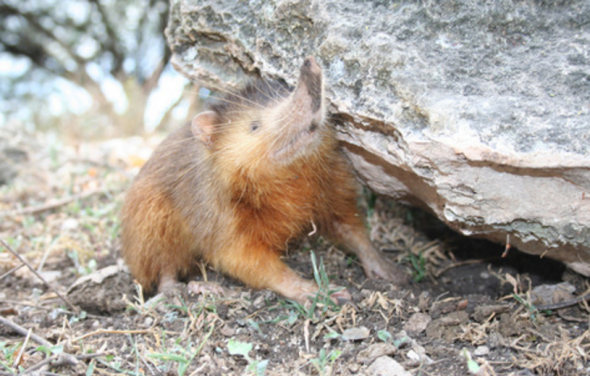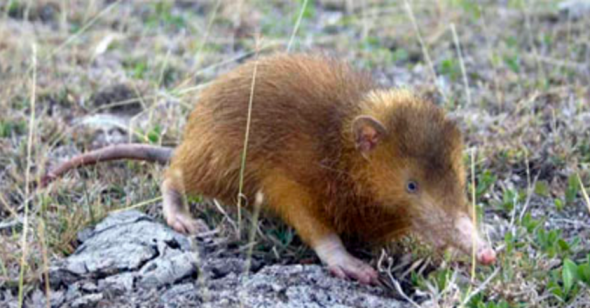Endangered Species Friday: Solenodon paradoxus | Extinction is Imminent.
Endangered Species Friday: Solenodon paradoxus
This Friday’s (Endangered Species Post) E.S.P, I touch up again on the Hispaniolan Solenodon, scientifically identified as Solenondon paradoxus. Image credit: Mr Jose Nunez-Mino. My reasons for re-documenting on this species is primarily due to my belief that extinction is now most certainly imminent. Therefore for that reason I think its critical that we all make as much noise as possible for this little one due to is importance within the theater of conservation, and because its one of very few mammals that do actually host a venomous side to them.
Written by Dr Jose C. Depre; Botanical and Conservation Scientist.
Solenondon paradoxus was identified back in 1883 by Dr Johann Friedrich von Brandt (25 May 1802 – 15 July 1879) was a German naturalist. Brandt was born in Jüterbog and educated at a gymnasium in Wittenberg and the University of Berlin. In 1831 he was appointed director of the Zoological Department at the St Petersburg Academy of Sciences, where he published in Russian. Brandt encouraged the collection of native animals, many of which were not represented in the museum. Many specimens began to arrive from the expeditions of Severtzov, Przhevalsky, Middendorff, Schrenck and Gustav Radde.
Listed as (endangered) the species is endemic to the Dominican Republic; Haiti. Back in 1965 the species was re-located and reassessed of which scientists agreed the species ‘required watching due to concerns relating to low population levels’. Unfortunately, and despite the species then being known as severely threatened, from 1982-1996 the Solenondon paradoxus was re-listed as (endangered), now nearing almost complete extinction within the wild. It is without a doubt that we may be seeing this stunning “slotted tooth mammal” extinct within the next two to three years. The name Solenodon means ‘slotted tooth’ of which this insectivorous mammalian is known to be (venomous).
Population levels within the wild have been identified as (severely fragmented), and a population decrease within the species native wild has been ongoing since the early 1980’s, the mammal-like-shrew is considered to be extremely rare. Furthermore within Haiti the species “could be considered as critically endangered” due to an isolated population that covers only 100 kilometers square. Habit loss and persecution are the primary threats associated with the species.
The Haitian solenodon as the species is commonly known to the locals resides mainly next to plantations, forest and brush country. The species leads a mainly nocturnal life where it hides among rock clefts and under large stones, dark caves or hollow trees. Diet atypically consists of insects, but mainly spiders which the species digs from the ground and leaf litter. Small frogs and reptiles are also known to be part of the mammals diet. Haitian solenodon will use its long snout to sniff out food even buried deep into the ground then its powerful claws to locate food via burrowing which are about 2-4cms long, a venom will if required be administered to much larger prey.
The species is relatively social and does not live a solitary life, its been noted that the species prefers to live within groups of 5-8 within underground burrows, which is almost similar to the European moles behavior. Gestating females will normally give birth to 1-2 young and no more, young will always be born within the main family burrow. Young will remain with their mother for approximately seven to eight months, from which after maturity they are left to fend for themselves, however its been documented that the young and parents will ‘sometimes socialize and live together’.
Image credit: Mr Jorge Brocca
Currently under Dominican Republic law the species is protected under the General Environmental Law of 64-00. A recovery plan was published back in 1992 aimed at improving surveys, and management of the National Park Pic Macaya followed up with educational plans to help reduce species populations decline. A further implementation within the protection plan was to decrease exotic animal sales of the mammal and address these main issues wildly over the animals range.
Unfortunately since 1992 nothing “hard hitting” has been put into practice, and its quite likely that should anyone of the actions now be played out - its most likely to have no affect whatsoever due to the species now bordering complete extinction within the wild. However I myself do believe that we can only but try create as much noise as possible, applying pressure where needed thus forcing the Haitian Department of Environment, and Government to now protect this specie and implement whatever actions necessary to preserve this mammalian and its current habitat.
Major Threats
The most significant threat to this species appears to be the continuing demise of its forest habitat and predation by introduced rats, mongoose, cats and dogs, especially in the vicinity of human settlements. In Haiti persecution and hunting for food is a major threat, and there is devastating habitat destruction also occurring.
Venom Warning
Despite the fact humans and other predators prey on the animal, and the fact this animal is rather small, Solenondon paradoxus does indeed pack a small “unknown venomous punch”, and you’d not really want to be bitten by this little one. I cannot emphasize the importance of wearing “protective clothing in the way of gloves” should you come into contact with this animal. Venom is administered in more or less the same manner as snakes administer their venom (not poison). Please note there is a very big difference between (venom and poison).
The solenodon is particularly fascinating because it delivers its poison just as a snake does—using its teeth as a syringe to inject venom into its target. Not a lot is known about these unusual mammals. There are only two solenodon species: One lives on Cuba and the other on Hispaniola (home to Haiti and the Dominican Republic). At night when the species goes in search of food venom would typically be administered to more larger prey such as frogs, and smaller reptilians that the animal also feeds on, despite the animals diet mainly consisting of insects. While the venom is not “considered dangerous to humans” there is actually no hard hitting evidence that its venom is or isn’t dangerous.
The reason I state that, is because most handlers within zoological gardens do actually wear gloves in order to protect themselves from being bitten. So theoretically speaking it would be considered safe to say that while little is known about the animals venomous side - please wear gloves should you come into contact with the animal until more data can be located on the animals venom Etc.
There remains no current data in relation to how many mature and non-mature solenodon individuals there are within the wild, furthermore little is known about life expectancy, however locals have stated local populations can/have lived for up-to 5-7 years.
I am unsure what the future holds for this rather peculiar animal, its one of very few mammals that do actually have the ability to administer a venomous bite via its salivary glands too. The Hispaniolan solenodon represents a remarkable amount of unique evolutionary history, diverging from other living mammal groups some 75 million years ago and before the extinction of the dinosaurs. Conservation efforts don’t seem to be improving the animals population levels, however I am told that conservation actions have been planned. Will they work though now is another story.
The clock is ticking fast for this little one…While I want to believe that we can do something I do believe that its probably too late. Therefore I predict that my next document on this species will be informing the general public of its wild extinction. That would be considered quite sad to be fair regarding my look at things. Check out the video below.
“EXTINCTION IS IMMINENT”
Thank you for reading.
Dr Jose C. Depre. PhD. MEnvSc. BSc(Hons) Botany, PhD(NeuroSci) D.V.M.
Environmental, Botanical and Human Science.
Follow me on Twitter: https://twitter.com/josedepre11
Donate via our Facebook button: https://www.facebook.com/Anti-Pet-and-Bush-Meat-Coalition-474749102678817/app/117708921611213/
Sign up here: https://www.facebook.com/Anti-Pet-and-Bush-Meat-Coalition-474749102678817/app/100265896690345/
Whatever you do may seem insignificant to you, but its most important that you do it!





